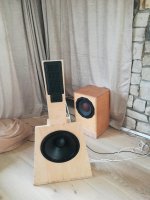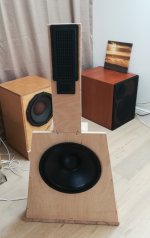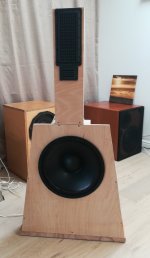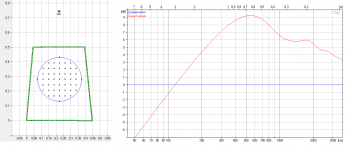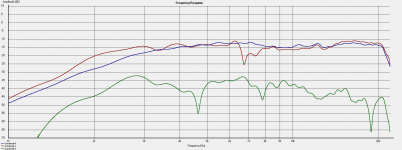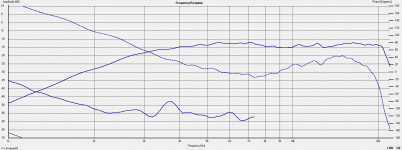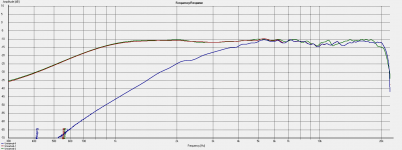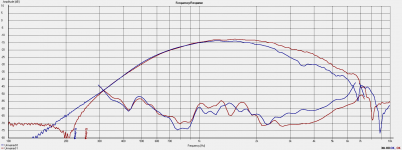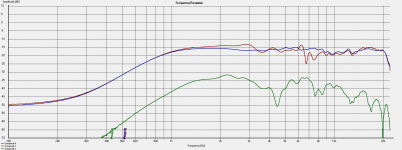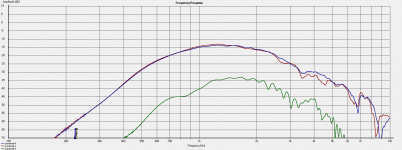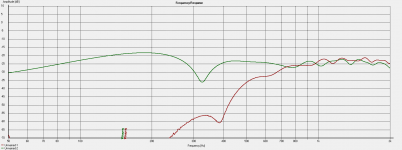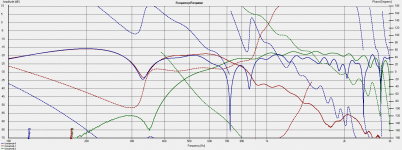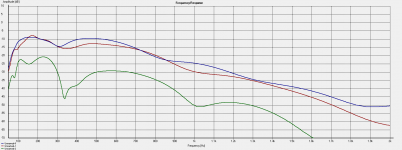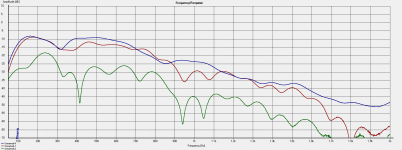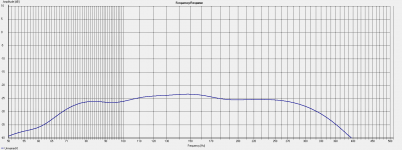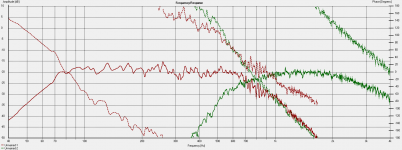After 10 days of planning and 2 days of building: an OB
With about 365 times less procrastination than last time After a decade of planning, thanks to forum members after reading The 'Circles of Doom'.....Open baffleless full range speakers. I thought - it’s about 14 years since I’ve tried OB, so…
My goal was to use drivers I could get my hands on within a week or so and build something easy.
The Neo3 and Neo10 happened to be available and are irresistible. I did some simulations and decided to use the Neo3 on its “side”, underneath the latter, with minimal gap aiming for (and it turns out achieving) a 3kHz LR24 crossover. The baffle is routed out behind and flat in front. A quick test baffle showed this is fine, with baffle effects on the Neo3 significantly below the crossover (I had wondered about scalloping out the wood either side of the Neo3 but decided not to).
I’ve got four subwoofers of three types and decided to use those up to ~90Hz. This decision is based on room modes and consideration of the location that the new speakers would have to occupy, to be far enough from walls.
The aim was to use an LR24 crossover around 700Hz from the Neo10 to an OB base driver with proportionately larger spacing (it’s 660mm c2c, and the crossover is a little under 700 Hz). The lower baffle is mildly U-shaped, with tapered rear “wings” mainly for bracing. I wanted to keep the base width no more than 2’ or 61cm.
After looking at easily available bass drives of trustworthy/known quality, I chose the B&C 14NDL76 as a cautious compromise. A 15” would also fit in the tapering baffle at the desired height, but I knew that the 14NDL76 has a smooth response and would give some margin to adjust the crossover upwards if I had trouble with the low end of the Neo 10 (no sign of that, however).
The drivers arrived promptly, and it took about 8 hours to build the speakers in two sessions split by varnish drying overnight, an hour to burn-in the bass drives, and an hour or so to wire, test and set up the EQ. I only have limited hand tools and very limited skill, which none-the-less proved sufficient (a nice new saw, electric drill/screwdriver, electric jigsaw with thin blade, files, sandpaper, and a router with round-over bit for the back of the upper baffle).
The baffles have some added stiffening strips, as well as the wings on the lower part; these taper from ~1cm at the top to ~10cm at the bottom. The lower baffles are fixed on to iroko butcher block off-cuts from earlier speakers and are ideal to add mass and make a stable platform.
The whole speaker sits on compliant, damped feet, to give a ~10Hz low-Q rocking resonance. The connections between the upper and lower baffles are also compliant and damped (metal flexures and damping). This connection was tuned to avoid resonances of the lower baffle and I cannot feel vibrations of the lower baffle on the upper – the rocking mode is about 40Hz. The upper baffle could benefit from some more damping or stiffening in its lower part, but the radiating area is small and the resonances are not conspicuous with a microphone placed nearby below the tweeter – more investigation of this later.
The Neo3s required EQ to achieve a flat response, as expected. That done, they blended almost ideally with the Neo10 (30dB tweeter-axis, reverse null with symmetrical LR24). The Neo10s only required a small boost below the lower crossover frequency to blend nicely with the 14NDL76 with LR24. The bass required some boost (4dB 90Hz Q=0.8), and I put a mild notch at 2kHz (-4dB Q=4), though not really needed. The response is generally smoother than the B&C datasheet suggests, but the trends are accurate.
As the speakers were only finished a few hours ago, I haven’t fully dialled in the four subs – only roughly: good enough to be enjoying music. Though I gave the 14NDL76s some LF work for an hour, their suspensions will possibly soften up a little more and I’ll revisit the bass-EQ again in a week or so.
The Neo10s measured almost identically, as did the 14NDL76s. The Neo3s differed by up to 1dB in a band around 10 kHz – whether this is from the drivers or due to small differences in the way I mounted them is unclear. I plan some front/rear measurements that might give a clue (sometime).
I used push-on connectors for the Neos, and the B&C drives came with spring connectors.
I hope the photos give the rough idea.
Editing to point to the main changes and discoveries since writing the above.
Improved understanding of early reflections, and the benefits of dipoles in this regard - mentioned at various places, mainly around #90. I could write more on this, as it's one of the most important considerations for choosing hifi speakers in a small room.
The first 44 posts describe the development and testing of the speakers with DCX2496 filters. The change to Hypex FA123 is described here: https://www.diyaudio.com/community/...to-one-forum-member-an-ob.374532/post-6801982
Although not fundamentally different, the extra DSP flexibility has allowed finer tuning in a few minor areas.
DRC was introduced https://www.diyaudio.com/community/...to-one-forum-member-an-ob.374532/post-6802001
Having good control of early reflections by design and positioning of speakers makes it easier to figure out how to best use (gentle) DRC for speaker and room correction in different regions of time-frequency space. I have a much better appreciation of how Toole & Olive and Bech et al findings fit together allowing proper consideration of early reflections. To communicate this in full would take many words - only the gist is in the thread.
Moving the bass-mid crossover down to ~400Hz (hence one lobe) came late, and only led to good outcomes: https://www.diyaudio.com/community/...to-one-forum-member-an-ob.374532/post-6888697
this extent of the change caught me by surprise (even setting aside the error during the comparison with the higher crossover (see #87) - the error did lead to a lot of interesting comments.
Thanks again to everyone who commented and contributed along the way. The project is now complete and I don't plan to add posts, unless interesting questions come up.
Ken
With about 365 times less procrastination than last time After a decade of planning, thanks to forum members after reading The 'Circles of Doom'.....Open baffleless full range speakers. I thought - it’s about 14 years since I’ve tried OB, so…
My goal was to use drivers I could get my hands on within a week or so and build something easy.
The Neo3 and Neo10 happened to be available and are irresistible. I did some simulations and decided to use the Neo3 on its “side”, underneath the latter, with minimal gap aiming for (and it turns out achieving) a 3kHz LR24 crossover. The baffle is routed out behind and flat in front. A quick test baffle showed this is fine, with baffle effects on the Neo3 significantly below the crossover (I had wondered about scalloping out the wood either side of the Neo3 but decided not to).
I’ve got four subwoofers of three types and decided to use those up to ~90Hz. This decision is based on room modes and consideration of the location that the new speakers would have to occupy, to be far enough from walls.
The aim was to use an LR24 crossover around 700Hz from the Neo10 to an OB base driver with proportionately larger spacing (it’s 660mm c2c, and the crossover is a little under 700 Hz). The lower baffle is mildly U-shaped, with tapered rear “wings” mainly for bracing. I wanted to keep the base width no more than 2’ or 61cm.
After looking at easily available bass drives of trustworthy/known quality, I chose the B&C 14NDL76 as a cautious compromise. A 15” would also fit in the tapering baffle at the desired height, but I knew that the 14NDL76 has a smooth response and would give some margin to adjust the crossover upwards if I had trouble with the low end of the Neo 10 (no sign of that, however).
The drivers arrived promptly, and it took about 8 hours to build the speakers in two sessions split by varnish drying overnight, an hour to burn-in the bass drives, and an hour or so to wire, test and set up the EQ. I only have limited hand tools and very limited skill, which none-the-less proved sufficient (a nice new saw, electric drill/screwdriver, electric jigsaw with thin blade, files, sandpaper, and a router with round-over bit for the back of the upper baffle).
The baffles have some added stiffening strips, as well as the wings on the lower part; these taper from ~1cm at the top to ~10cm at the bottom. The lower baffles are fixed on to iroko butcher block off-cuts from earlier speakers and are ideal to add mass and make a stable platform.
The whole speaker sits on compliant, damped feet, to give a ~10Hz low-Q rocking resonance. The connections between the upper and lower baffles are also compliant and damped (metal flexures and damping). This connection was tuned to avoid resonances of the lower baffle and I cannot feel vibrations of the lower baffle on the upper – the rocking mode is about 40Hz. The upper baffle could benefit from some more damping or stiffening in its lower part, but the radiating area is small and the resonances are not conspicuous with a microphone placed nearby below the tweeter – more investigation of this later.
The Neo3s required EQ to achieve a flat response, as expected. That done, they blended almost ideally with the Neo10 (30dB tweeter-axis, reverse null with symmetrical LR24). The Neo10s only required a small boost below the lower crossover frequency to blend nicely with the 14NDL76 with LR24. The bass required some boost (4dB 90Hz Q=0.8), and I put a mild notch at 2kHz (-4dB Q=4), though not really needed. The response is generally smoother than the B&C datasheet suggests, but the trends are accurate.
As the speakers were only finished a few hours ago, I haven’t fully dialled in the four subs – only roughly: good enough to be enjoying music. Though I gave the 14NDL76s some LF work for an hour, their suspensions will possibly soften up a little more and I’ll revisit the bass-EQ again in a week or so.
The Neo10s measured almost identically, as did the 14NDL76s. The Neo3s differed by up to 1dB in a band around 10 kHz – whether this is from the drivers or due to small differences in the way I mounted them is unclear. I plan some front/rear measurements that might give a clue (sometime).
I used push-on connectors for the Neos, and the B&C drives came with spring connectors.
I hope the photos give the rough idea.
Editing to point to the main changes and discoveries since writing the above.
Improved understanding of early reflections, and the benefits of dipoles in this regard - mentioned at various places, mainly around #90. I could write more on this, as it's one of the most important considerations for choosing hifi speakers in a small room.
The first 44 posts describe the development and testing of the speakers with DCX2496 filters. The change to Hypex FA123 is described here: https://www.diyaudio.com/community/...to-one-forum-member-an-ob.374532/post-6801982
Although not fundamentally different, the extra DSP flexibility has allowed finer tuning in a few minor areas.
DRC was introduced https://www.diyaudio.com/community/...to-one-forum-member-an-ob.374532/post-6802001
Having good control of early reflections by design and positioning of speakers makes it easier to figure out how to best use (gentle) DRC for speaker and room correction in different regions of time-frequency space. I have a much better appreciation of how Toole & Olive and Bech et al findings fit together allowing proper consideration of early reflections. To communicate this in full would take many words - only the gist is in the thread.
Moving the bass-mid crossover down to ~400Hz (hence one lobe) came late, and only led to good outcomes: https://www.diyaudio.com/community/...to-one-forum-member-an-ob.374532/post-6888697
this extent of the change caught me by surprise (even setting aside the error during the comparison with the higher crossover (see #87) - the error did lead to a lot of interesting comments.
Thanks again to everyone who commented and contributed along the way. The project is now complete and I don't plan to add posts, unless interesting questions come up.
Ken
Attachments
Last edited:
This looks great. I have a couple of comments about the woofer corrections. There are two things that tend to change the response of an OB woofer:
1. Near resonance rolloff: In an OB, the drooping response of this B&C woofer at its 40Hz resonance will be similar to free air or infinite baffle response. This will pull down the SPL where you cross to the subs, however, it looks like you already added a 4dB boost there. The FR plot in the MFG datasheet for the drivers hints that sort of correction is about right or could even be increased by a couple of dB.
2. The dipole response of the woofer: I didn't see you mention any correction for it. The small baffle size will cause the response to trend down towards the lower frequencies at 6dB/octave over pretty much the entire passband. With a little over 2 octaves between 90Hz and 700Hz you might try 12dB of total EQ in a first order shelf EQ type correction. The best way to do that is to cut power as frequency increases, then match the level to the other drivers. This will offset the rising response of the driver in the modestly sized baffle and help to give a fuller midbass tonal character to the speaker. This will eat up some of the sensitivity of the woofer. It claims about 99dB/W, and that looks about right from the datasheet, but that is without the dipole losses. So at 100Hz the actual 1W SPL is more like 87dB.
Have you been able to make any measurements, or is this all dialed in "by ear"?
1. Near resonance rolloff: In an OB, the drooping response of this B&C woofer at its 40Hz resonance will be similar to free air or infinite baffle response. This will pull down the SPL where you cross to the subs, however, it looks like you already added a 4dB boost there. The FR plot in the MFG datasheet for the drivers hints that sort of correction is about right or could even be increased by a couple of dB.
2. The dipole response of the woofer: I didn't see you mention any correction for it. The small baffle size will cause the response to trend down towards the lower frequencies at 6dB/octave over pretty much the entire passband. With a little over 2 octaves between 90Hz and 700Hz you might try 12dB of total EQ in a first order shelf EQ type correction. The best way to do that is to cut power as frequency increases, then match the level to the other drivers. This will offset the rising response of the driver in the modestly sized baffle and help to give a fuller midbass tonal character to the speaker. This will eat up some of the sensitivity of the woofer. It claims about 99dB/W, and that looks about right from the datasheet, but that is without the dipole losses. So at 100Hz the actual 1W SPL is more like 87dB.
Have you been able to make any measurements, or is this all dialed in "by ear"?
Last edited:
Thanks - it's part calculated, mostly measured. I should mention that I consulted a few of your posts in the past week too.
As an experimental physicist, measurement is most of my life ...
I carried out measurements at various distances (0.2m to 2m), using Holm Impulse. The tweeter and mid were properly gated at the closer range, no problems. The bass is a mixture of gating and ignoring/accounting for effects of floor bounce etc. as the distance increases. These measurements will need to be refined.
The reason I'm not showing measurements yet, is that as you know it takes a lot of effort to present in-room measurements that are easy to interpret without pages of explanation.
Specific to your points:
1. I pre-calculated this as part of the driver selection. The boost I need in practice (allowing also for the OB slope) is a little less than I'd expected, and I might have to revisit that, but it's within two dB of what I expected.
2. Oops, I see I forgot to mention that important point. The dipole peak comes out about 350Hz, I knocked that down with a notch of about -4dB Q=3. That a compromise between the crossover phase/slope and the OB correction, so it ended up below the dipole peak. This won't be exactly right yet, but I'll leave fine adjustment of the last dB or two until the 14NDL76s have softened up. I expect I'll need a bit more boost around 100Hz and a bit more cut around 400Hz.
Ken
Edit: If I did it by ear it would take me half-way to forever!
As an experimental physicist, measurement is most of my life ...
I carried out measurements at various distances (0.2m to 2m), using Holm Impulse. The tweeter and mid were properly gated at the closer range, no problems. The bass is a mixture of gating and ignoring/accounting for effects of floor bounce etc. as the distance increases. These measurements will need to be refined.
The reason I'm not showing measurements yet, is that as you know it takes a lot of effort to present in-room measurements that are easy to interpret without pages of explanation.
Specific to your points:
1. I pre-calculated this as part of the driver selection. The boost I need in practice (allowing also for the OB slope) is a little less than I'd expected, and I might have to revisit that, but it's within two dB of what I expected.
2. Oops, I see I forgot to mention that important point. The dipole peak comes out about 350Hz, I knocked that down with a notch of about -4dB Q=3. That a compromise between the crossover phase/slope and the OB correction, so it ended up below the dipole peak. This won't be exactly right yet, but I'll leave fine adjustment of the last dB or two until the 14NDL76s have softened up. I expect I'll need a bit more boost around 100Hz and a bit more cut around 400Hz.
Ken
Edit: If I did it by ear it would take me half-way to forever!
Last edited:
The frequency response of the woofer in your system is probably something like the attached plot, although this is not taking into account the down-turn in SPL due to the near resonance response below 100Hz or so. I used TheEdge to model it. I didn't have your baffle dims so I guesstimated them.
As you can see, there is a more or less continuous 6dB/oct slope to it, and you will need EQ to flatten that out.
As you can see, there is a more or less continuous 6dB/oct slope to it, and you will need EQ to flatten that out.
Attachments
Hi Ken,
You posted while I was writing the post with the model of FR. Thanks for all the additional details. Measurements are definitely not easy to do well for an OB. Looks like you are on top of it all! Great stuff.
You posted while I was writing the post with the model of FR. Thanks for all the additional details. Measurements are definitely not easy to do well for an OB. Looks like you are on top of it all! Great stuff.
Thanks again.
Edge doesn't really represent the "wings", but if I "fold them out" the equivalent baffle is perhaps about 0.8m wide at the bottom, tapering to 0.4m at the top. The predicted dipole peak is then about 350Hz. I went for the tapered shape enhanced by wings to "blunt" the peak a bit. As you know, that gives a response that's substantially wider than a rectangular baffle, easing correction. This shape was a basic input to the design, deriving from experience with smaller baffles and 8 inch drivers 14 years ago. It's much easier to make tapered shapes when there's no box!
Ken
Edge doesn't really represent the "wings", but if I "fold them out" the equivalent baffle is perhaps about 0.8m wide at the bottom, tapering to 0.4m at the top. The predicted dipole peak is then about 350Hz. I went for the tapered shape enhanced by wings to "blunt" the peak a bit. As you know, that gives a response that's substantially wider than a rectangular baffle, easing correction. This shape was a basic input to the design, deriving from experience with smaller baffles and 8 inch drivers 14 years ago. It's much easier to make tapered shapes when there's no box!
Ken
ps. to #6
my aim was to get the dipole peak an octave below the bass-mid crossover, while covering 2.5 to at most 3 octaves with the 14NDL76, yet keeping the baffle reasonably compact to avoid too many resonances.
I could have made deeper wings, but have previously seen trouble with the free edges vibrating and coupling strongly to bowing modes of the front panel.
Putting the dipole peak at 350 Hz is a compromise that works well with the upper crossover and yet doesn't need a huge correction boost.
The 14NDL76 has fs ~ 41Hz, and Qts ~0.3, so the damping loss is indeed becoming significant around 100Hz. The boost I've given based on initial measurements is likely a couple of dB too small to account for the dipole fall-off of 4dB from 150 to 90 Hz and the damping loss. As noted, I suspect that Qts and fs might change, so I'll revisit the boost and confirm the result in a later post.
With the smaller baffle of After 10 days of planning and 2 days of building; thanks to one forum member / an OB I would have needed several dB more boost, at 90Hz - beyond what I had in mind. I see why my omission of the correction in the first post was conspicuous.
Ken
my aim was to get the dipole peak an octave below the bass-mid crossover, while covering 2.5 to at most 3 octaves with the 14NDL76, yet keeping the baffle reasonably compact to avoid too many resonances.
I could have made deeper wings, but have previously seen trouble with the free edges vibrating and coupling strongly to bowing modes of the front panel.
Putting the dipole peak at 350 Hz is a compromise that works well with the upper crossover and yet doesn't need a huge correction boost.
The 14NDL76 has fs ~ 41Hz, and Qts ~0.3, so the damping loss is indeed becoming significant around 100Hz. The boost I've given based on initial measurements is likely a couple of dB too small to account for the dipole fall-off of 4dB from 150 to 90 Hz and the damping loss. As noted, I suspect that Qts and fs might change, so I'll revisit the boost and confirm the result in a later post.
With the smaller baffle of After 10 days of planning and 2 days of building; thanks to one forum member / an OB I would have needed several dB more boost, at 90Hz - beyond what I had in mind. I see why my omission of the correction in the first post was conspicuous.
Ken
Measurement time
In the past week of listening, nothing objectionable has shown up - this has never happened before with speakers. As I'm not going to change the EQ and XO of the GRS drivers, it's time to present some measurements. These are all in-room with Holm impulse. I believe the mic is good to about 10kHz, though it's a long time since calibration.
The tweeter (T) is PT2522-4; the mid (M) is PT5010-8 and the bass (B) is the 14NDL76. The T and M measurements worked out quite nicely, and don't need many caveats. The gating should be shown on the plots and otherwise it's default settings. These measurements are all on the tweeter axis. Each measurement is done from about as close as possible without being misleading, by trial and error.
I'll split this up into short posts in case I make an error and need to correct. Hopefully some part of this is useful to someone exploring OB. One thing is for sure, it's much easier to produce satisfactory results than with any other approach to speakers I've tried, especially the "fractal arrays" which are, comparatively, a measurement nightmare.
Ken
In the past week of listening, nothing objectionable has shown up - this has never happened before with speakers. As I'm not going to change the EQ and XO of the GRS drivers, it's time to present some measurements. These are all in-room with Holm impulse. I believe the mic is good to about 10kHz, though it's a long time since calibration.
The tweeter (T) is PT2522-4; the mid (M) is PT5010-8 and the bass (B) is the 14NDL76. The T and M measurements worked out quite nicely, and don't need many caveats. The gating should be shown on the plots and otherwise it's default settings. These measurements are all on the tweeter axis. Each measurement is done from about as close as possible without being misleading, by trial and error.
I'll split this up into short posts in case I make an error and need to correct. Hopefully some part of this is useful to someone exploring OB. One thing is for sure, it's much easier to produce satisfactory results than with any other approach to speakers I've tried, especially the "fractal arrays" which are, comparatively, a measurement nightmare.
Ken
Tweeter GRS2522
The first measurements are in front (b), in rear (r) and to side (g) of dipole at about 20cm from the membrane. The rear radiation shows the effect of the cavity behind the tweeter, in the 6-8 kHz band. This is why I front mounted the tweeter. A thinner baffle around the tweeter might be a good idea to achieve a flatter rear radiation pattern. Gating was 4ms.
The side radiation is mostly ~25dB down.
The second shows the front measurement with an estimate phase and THD at what would be mid-90s dB (more on THD below).
The third shows an attempt at 3rd HD - the only one that produced (possibly) meaningful results, with the expected increase with level. As the level was increased in ~6dB steps the measurement distance was also increased in proportion to keep the measured level similar.
The highest level was somewhere over 100dB at 1m.
2nd HD showed little change with level in the band, 5th HD showed an increase at the highest level (but of course only right at the bottom of the range). I'm not placing much value or emphasis on HD measurements, but they show that nothing bad happens at the levels tested, which are more than enough for my ears.
Next will come the mids and mid-tweeter XO.
Note that all XOs and EQ are currently implemented using a pair of DCX2496.
The first measurements are in front (b), in rear (r) and to side (g) of dipole at about 20cm from the membrane. The rear radiation shows the effect of the cavity behind the tweeter, in the 6-8 kHz band. This is why I front mounted the tweeter. A thinner baffle around the tweeter might be a good idea to achieve a flatter rear radiation pattern. Gating was 4ms.
The side radiation is mostly ~25dB down.
The second shows the front measurement with an estimate phase and THD at what would be mid-90s dB (more on THD below).
The third shows an attempt at 3rd HD - the only one that produced (possibly) meaningful results, with the expected increase with level. As the level was increased in ~6dB steps the measurement distance was also increased in proportion to keep the measured level similar.
The highest level was somewhere over 100dB at 1m.
2nd HD showed little change with level in the band, 5th HD showed an increase at the highest level (but of course only right at the bottom of the range). I'm not placing much value or emphasis on HD measurements, but they show that nothing bad happens at the levels tested, which are more than enough for my ears.
Next will come the mids and mid-tweeter XO.
Note that all XOs and EQ are currently implemented using a pair of DCX2496.
Attachments
Mids GRS5010
First the equivalent front (b), rear (r) and side (g) measurements for the mids, on tweeter axis at about 35cm. Here there's really no sign of trouble from the baffle. I changed the lower-end crossover slightly later on, to modify the blend with the bass. Here the gating is again 4ms.
The second plot shows the same with the mid and tweeter active. The XO seems to work OK, though makes a slight excess behind. Here the gating is 2ms, as there was a reflection on the side measurement (from a surface).
The next plot shows - nothing useful - 3rd HD at the two higher levels matching the tweeter measurements. Again moving the microphone, and the higher (red) measurement is again, I believe, in the 100dB SPL range at 1m. Spectacularly little to see there, and nothing convincing in the higher harmonics either. Wow.
The last plot shows as close as I could manage a fair comparison of the two speakers - red and green are the curves to compare. This required placing the microphone placed to a couple of mm in 3D. Concerns had been raised about QC on the GRS units. At least for the mids, I see no sign of that at all. Wow, again. Note that the gating is 2ms, the measurement distance was roughly 601mm on the tweeter axis, from the front of the tweeter to the front of the mic. Sorry that blue overlaps red at HF, I should have hidden it.
I'm not too worried about the tweeter differences over 10 kHz.
Ken
First the equivalent front (b), rear (r) and side (g) measurements for the mids, on tweeter axis at about 35cm. Here there's really no sign of trouble from the baffle. I changed the lower-end crossover slightly later on, to modify the blend with the bass. Here the gating is again 4ms.
The second plot shows the same with the mid and tweeter active. The XO seems to work OK, though makes a slight excess behind. Here the gating is 2ms, as there was a reflection on the side measurement (from a surface).
The next plot shows - nothing useful - 3rd HD at the two higher levels matching the tweeter measurements. Again moving the microphone, and the higher (red) measurement is again, I believe, in the 100dB SPL range at 1m. Spectacularly little to see there, and nothing convincing in the higher harmonics either. Wow.
The last plot shows as close as I could manage a fair comparison of the two speakers - red and green are the curves to compare. This required placing the microphone placed to a couple of mm in 3D. Concerns had been raised about QC on the GRS units. At least for the mids, I see no sign of that at all. Wow, again. Note that the gating is 2ms, the measurement distance was roughly 601mm on the tweeter axis, from the front of the tweeter to the front of the mic. Sorry that blue overlaps red at HF, I should have hidden it.
I'm not too worried about the tweeter differences over 10 kHz.
Ken
Attachments
Bass - the hard bit.
In earlier posts I'd described roughly how I EQ the bass, and XO'd to the mid. I had a few attempts at improving the XO and tried some more traditional dipole EQ (1/f filter below the dipole peak). I had guessed 90Hz for the lower cutoff and found that is about right, but I've made the response below 100Hz drop off a little more gradually. I don't want to be too definite, as the in-room measurements are of course a nightmare - I mixed close-up, listening-position and intermediate measurements and won't post most of them.
The following is therefore a flavor of the bass-mid integration and the next post is intended to show the response in the hundred-Hz region. I did not manage to get any very convincing HD measurements - there's a hint that 3rd HD rises at about 105dB SPL 1m in a band 90-110 Hz, but the result was too dependent on gating, and didn't show reasonable level dependence. No conspicuous sign of stress.
The first plot is front (b), rear (r) and side (g) with 10ms gating, therefore catching a couple of reflections (the dips around 1kHz are due to such). The linear scale is by accident. The measurement distance is about 1.2m.
The second plot shows similar to the first but with "complex smoothing" not sure if all that helpful here.
The 3rd plot is an example of what I usually see when not preparing plots for show. What a mess. When disentangled, this shows bass (red), mid + tweeter (green) and sum (blue) solid magnitude and dashed phase (estimate). This is with the bass inverted, so there's a null near the XO. It's a snapshot of a set of similar measurements at different mic positions. It's with an intermediate XO which was adjusted further.
The last shows a resulting blend measured on the listening axis, with floor bounces, but a reasonably smooth XO at around 660Hz - 6ms gating lets in a few reflections hence the ripples.
Last measurement post to follow.
Ken
In earlier posts I'd described roughly how I EQ the bass, and XO'd to the mid. I had a few attempts at improving the XO and tried some more traditional dipole EQ (1/f filter below the dipole peak). I had guessed 90Hz for the lower cutoff and found that is about right, but I've made the response below 100Hz drop off a little more gradually. I don't want to be too definite, as the in-room measurements are of course a nightmare - I mixed close-up, listening-position and intermediate measurements and won't post most of them.
The following is therefore a flavor of the bass-mid integration and the next post is intended to show the response in the hundred-Hz region. I did not manage to get any very convincing HD measurements - there's a hint that 3rd HD rises at about 105dB SPL 1m in a band 90-110 Hz, but the result was too dependent on gating, and didn't show reasonable level dependence. No conspicuous sign of stress.
The first plot is front (b), rear (r) and side (g) with 10ms gating, therefore catching a couple of reflections (the dips around 1kHz are due to such). The linear scale is by accident. The measurement distance is about 1.2m.
The second plot shows similar to the first but with "complex smoothing" not sure if all that helpful here.
The 3rd plot is an example of what I usually see when not preparing plots for show. What a mess. When disentangled, this shows bass (red), mid + tweeter (green) and sum (blue) solid magnitude and dashed phase (estimate). This is with the bass inverted, so there's a null near the XO. It's a snapshot of a set of similar measurements at different mic positions. It's with an intermediate XO which was adjusted further.
The last shows a resulting blend measured on the listening axis, with floor bounces, but a reasonably smooth XO at around 660Hz - 6ms gating lets in a few reflections hence the ripples.
Last measurement post to follow.
Ken
Attachments
Dipole EQ
Following the new EQ which has a shelving filter, gentle notch at the dipole peak, gentle boost just below the intended lower cutoff and a minor corrective notch just below the upper crossover, I tried to find a way to show the response.
The measurement is only valid up to around 300Hz (with a huge dip due to reflections above there). The first plot is with nearly 20ms gating, the second with complex smoothing. They're very smooth, so I zoomed in.
I wanted these measurements to come out at about the level they did, extrapolating from some of the earlier measurements. I can't see a way, without far too much smoothing, to present the response from 100Hz to 1kHz intact.
I've started re-integrating my four subs (4th order BP, reflex and two sealed) and have something roughly right (using noise measurements and keeping room modes in mind), but that's enough measuring for one day. Back to music.
So glad I'm not doing this passive ... I'll see about posting more of the EQ details another time.
Ken
Following the new EQ which has a shelving filter, gentle notch at the dipole peak, gentle boost just below the intended lower cutoff and a minor corrective notch just below the upper crossover, I tried to find a way to show the response.
The measurement is only valid up to around 300Hz (with a huge dip due to reflections above there). The first plot is with nearly 20ms gating, the second with complex smoothing. They're very smooth, so I zoomed in.
I wanted these measurements to come out at about the level they did, extrapolating from some of the earlier measurements. I can't see a way, without far too much smoothing, to present the response from 100Hz to 1kHz intact.
I've started re-integrating my four subs (4th order BP, reflex and two sealed) and have something roughly right (using noise measurements and keeping room modes in mind), but that's enough measuring for one day. Back to music.
So glad I'm not doing this passive ... I'll see about posting more of the EQ details another time.
Ken
Attachments
Hi Ken so glad you are enjoying your new speakers! They look great!
Hope you enjoy your experiments in open baffle as much as I am.
At the moment they are the best speakers I have heard and have stopped tweaking them (which has never happened before!) Even though I know they are only roughly tuned in at present.
Hope you enjoy your experiments in open baffle as much as I am.
At the moment they are the best speakers I have heard and have stopped tweaking them (which has never happened before!) Even though I know they are only roughly tuned in at present.
I would be very interested in your listening impressions when they are properly dialed in, as you have line arrays and waveguide/horn two ways, both I haven't got as comparisons.
Thank you
Bushmeister,
thanks for the compliment, the interest, and most of all your thread which led me to ask myself why it was so long since I'd tried OBs. It made me rethink the reason I'd attempted fractal arrays (more on that below), i.e., to have speakers that worked against the wall - what if I could make speakers that worked away from the wall?
I'd spent years moving conventional speakers around - the Harpers with various combinations of assisting woofers and subwoofers, but while I could deal with side-wall reflections was only happy with front-wall reflections when I fired them down the long axis of the room and kept the monopoles 2 to 2.5m from the front wall, with the listening seat also far from the back wall, leading to a cramped arrangement.
I thought that if I tried fractal arrays I might get speakers that work against the wall firing across the shorter dimension. This is partly successful, but the speakers sound "vague" with many multi-mic'ed recordings. See my 10 years ... thread for excerpts of my exploration in that area.
Circles of Doom made me reconsider that I might be able to place OBs ~4 feet from the front wall, and ~6 feet from the side walls, and find an angle that would work in the mid-bass. So I thought I'd try.
I'd been put off by the reports of poor QC with the GRS "tweeters".
Anyway, I used push-on connectors and don't see problems.
I dislike dome tweeters, there's always a signature - I've never quite worked out what, but I suspect geometrical effects between the dome/surround and whatever is near there, likely showing as subtle response variations around 7 to 10 kHz - I might be wrong about that. That also applies to the waveguide-tweeters in the fractal arrays - I couldn't completely eliminate the effect. The arrays are currently under investigation in the "workshop". The tiny CDs in Harpers are free of this effect (DE10, 25mm coil) but I can hear a slight resonance up high that also annoys me on some recordings.
I didn't go for line arrays, as despite obviously great projects in the forums, I can never see a convincing way to get two columns of speakers to yield a good horizontal response at the crossover. The main reason is that it would be stretching my patience to cut a few dozen holes, then having to do it all again and perhaps again: nope, not fun.
I was hoping that the GRS drivers would be innocent in this respect, and so far I can't hear anything that is going to annoy me. They seem tolerant of baffle design, though if I were a perfectionist, I might put the tweeter on a thinner baffle - probably metal, a few mm thick. I like that the mid and tweeter can work on the same baffle, as well.
From 670Hz up these are by far the least-tweaked speakers I've ever made: flat on tweeter axis seems to produce as close to the desired balance as I can tell. I've had no inclination to change that since day 1, which is amazing. They pass every test I can think of, including listening far away, and the power balance seems to work better than I would have dreamt.
The bass OB is trickier as I needed to figure out a good simulation plus measurement strategy. I realize that I didn't have that clear when I posted yesterday, and I have updated the OB EQ very slightly. An approach like "Edge" doesn't reflect reality, in room, but gives a clue as a starting point.
While you chose a dipole response down to somewhere in the 30s Hz, my OBs transition to four subs at what turns out to be 80Hz (estimating from the total power response, there's no conventional crossover). There are a few minor dips between 90Hz and 200Hz, and the floor bounces, which I partly obstruct with soft furnishing. I'm not convinced that I'm going to gain from moving the transition down to 40Hz or below. Certainly for now, single or orchestral bass instruments playing up scales from their lowest notes (~40Hz) don't show conspicuous problems in that octave.
I'm skirting around making comparisons, as those are so room dependent. What can I say? With respect to tone and balance, I'm completely happy - happier than I've ever been with little tweaking, for sure. There are no defects that call attention to the speakers, and that's never been true before. I thought I heard a strange "wrong sibilance" sound on female vocal track but headphones confirmed it was due to the vocalist's mic technique. It's rare for me to notice something on speakers that I'd missed on headphones (mid-range Sennheiser, open and closed) - perhaps this indicates something of the detail I'm hearing.
I've been listening to everything from Sibelius to Finnish Symphonic Metal, from great recordings with natural acoustics to synthetic mixes, and am generally happy with the clarity of the sound. It's interesting to hear mixed electronic and acoustic recordings (e.g. percussion that I know was recorded live mixed with electronic instruments) - it was like listening to two simultaneous tracks - the drums with their space, and the electronic parts mixed in as points (and sometimes panned). I certainly noticed this far more clearly than with the Harpers or fractal arrays. Perhaps I listened more carefully.
I suspect that these speakers have the most uniform in-room horizontal-plane response of any I've tried. Having dipole from bass to top does that. The Two crossovers have the same relative spacing/frequency hence vertical-lobing, and only the floor bounce is left as an obvious point of potential concern, but I'm not convinced it matters much due to brain filtering. I'll take the horizontal response every time.
That's a ramble.
Ken
Bushmeister,
thanks for the compliment, the interest, and most of all your thread which led me to ask myself why it was so long since I'd tried OBs. It made me rethink the reason I'd attempted fractal arrays (more on that below), i.e., to have speakers that worked against the wall - what if I could make speakers that worked away from the wall?
I'd spent years moving conventional speakers around - the Harpers with various combinations of assisting woofers and subwoofers, but while I could deal with side-wall reflections was only happy with front-wall reflections when I fired them down the long axis of the room and kept the monopoles 2 to 2.5m from the front wall, with the listening seat also far from the back wall, leading to a cramped arrangement.
I thought that if I tried fractal arrays I might get speakers that work against the wall firing across the shorter dimension. This is partly successful, but the speakers sound "vague" with many multi-mic'ed recordings. See my 10 years ... thread for excerpts of my exploration in that area.
Circles of Doom made me reconsider that I might be able to place OBs ~4 feet from the front wall, and ~6 feet from the side walls, and find an angle that would work in the mid-bass. So I thought I'd try.
I'd been put off by the reports of poor QC with the GRS "tweeters".
Anyway, I used push-on connectors and don't see problems.
I dislike dome tweeters, there's always a signature - I've never quite worked out what, but I suspect geometrical effects between the dome/surround and whatever is near there, likely showing as subtle response variations around 7 to 10 kHz - I might be wrong about that. That also applies to the waveguide-tweeters in the fractal arrays - I couldn't completely eliminate the effect. The arrays are currently under investigation in the "workshop". The tiny CDs in Harpers are free of this effect (DE10, 25mm coil) but I can hear a slight resonance up high that also annoys me on some recordings.
I didn't go for line arrays, as despite obviously great projects in the forums, I can never see a convincing way to get two columns of speakers to yield a good horizontal response at the crossover. The main reason is that it would be stretching my patience to cut a few dozen holes, then having to do it all again and perhaps again: nope, not fun.
I was hoping that the GRS drivers would be innocent in this respect, and so far I can't hear anything that is going to annoy me. They seem tolerant of baffle design, though if I were a perfectionist, I might put the tweeter on a thinner baffle - probably metal, a few mm thick. I like that the mid and tweeter can work on the same baffle, as well.
From 670Hz up these are by far the least-tweaked speakers I've ever made: flat on tweeter axis seems to produce as close to the desired balance as I can tell. I've had no inclination to change that since day 1, which is amazing. They pass every test I can think of, including listening far away, and the power balance seems to work better than I would have dreamt.
The bass OB is trickier as I needed to figure out a good simulation plus measurement strategy. I realize that I didn't have that clear when I posted yesterday, and I have updated the OB EQ very slightly. An approach like "Edge" doesn't reflect reality, in room, but gives a clue as a starting point.
While you chose a dipole response down to somewhere in the 30s Hz, my OBs transition to four subs at what turns out to be 80Hz (estimating from the total power response, there's no conventional crossover). There are a few minor dips between 90Hz and 200Hz, and the floor bounces, which I partly obstruct with soft furnishing. I'm not convinced that I'm going to gain from moving the transition down to 40Hz or below. Certainly for now, single or orchestral bass instruments playing up scales from their lowest notes (~40Hz) don't show conspicuous problems in that octave.
I'm skirting around making comparisons, as those are so room dependent. What can I say? With respect to tone and balance, I'm completely happy - happier than I've ever been with little tweaking, for sure. There are no defects that call attention to the speakers, and that's never been true before. I thought I heard a strange "wrong sibilance" sound on female vocal track but headphones confirmed it was due to the vocalist's mic technique. It's rare for me to notice something on speakers that I'd missed on headphones (mid-range Sennheiser, open and closed) - perhaps this indicates something of the detail I'm hearing.
I've been listening to everything from Sibelius to Finnish Symphonic Metal, from great recordings with natural acoustics to synthetic mixes, and am generally happy with the clarity of the sound. It's interesting to hear mixed electronic and acoustic recordings (e.g. percussion that I know was recorded live mixed with electronic instruments) - it was like listening to two simultaneous tracks - the drums with their space, and the electronic parts mixed in as points (and sometimes panned). I certainly noticed this far more clearly than with the Harpers or fractal arrays. Perhaps I listened more carefully.
I suspect that these speakers have the most uniform in-room horizontal-plane response of any I've tried. Having dipole from bass to top does that. The Two crossovers have the same relative spacing/frequency hence vertical-lobing, and only the floor bounce is left as an obvious point of potential concern, but I'm not convinced it matters much due to brain filtering. I'll take the horizontal response every time.
That's a ramble.
Ken
Why did you pick 700hz XO?
Vocals will be coming from a very low point.
Good OB designs place the 15" as close as possible to the floor and cross it around 180-250hz.
In your case the mid cannot go that low but 350-400hz is no problem... Which happens to correspond to the baffle peak in your case... Which also happens to be a good place for XO... Which also helps the CTC situation...
Vocals will be coming from a very low point.
Good OB designs place the 15" as close as possible to the floor and cross it around 180-250hz.
In your case the mid cannot go that low but 350-400hz is no problem... Which happens to correspond to the baffle peak in your case... Which also happens to be a good place for XO... Which also helps the CTC situation...
What a fantastic ramble Ken!
You have put into words so much of what I have been hearing too.
I am a headphone fan too and have planar headphones, dynamic drivers and quite expensive pairs that I use to help tune and often as a baseline for myself.
I have definitely experienced the same where I am picking up details that I missed even on my excellent hifiman Sundaras.
As I have said I always thought OB would be flawed due to the increased reflections - I assumed a more enveloping but 'hazy' presentation. The opposite to my synergy horn builds which are very headphone like. Who would have guessed that they would actually have greater detail, resolution and insight into the recordings?
The line array is the only build I haven't really pursued yet too - and if I am honest probably also due to the labour involved. If I am going to do one, I will do it right which means a lot of work! But having a variety of other speakers types to hand, a good selection of headphones, and a fair bit of experience in this hobby over the last 15-20 yrs I really at this moment can't see me attempting another build for many many years...
You have put into words so much of what I have been hearing too.
I am a headphone fan too and have planar headphones, dynamic drivers and quite expensive pairs that I use to help tune and often as a baseline for myself.
I have definitely experienced the same where I am picking up details that I missed even on my excellent hifiman Sundaras.
As I have said I always thought OB would be flawed due to the increased reflections - I assumed a more enveloping but 'hazy' presentation. The opposite to my synergy horn builds which are very headphone like. Who would have guessed that they would actually have greater detail, resolution and insight into the recordings?
The line array is the only build I haven't really pursued yet too - and if I am honest probably also due to the labour involved. If I am going to do one, I will do it right which means a lot of work! But having a variety of other speakers types to hand, a good selection of headphones, and a fair bit of experience in this hobby over the last 15-20 yrs I really at this moment can't see me attempting another build for many many years...
Interesting questions - short responses
zmyrna,
thanks, the points I think you are driving at are frequently reflected in other designs, but I chose differently, to suit my circumstances: a gamble that seems to be paying off.
~700Hz XO follows from the choice of mid + tweeter.
I did not want to use a small cone mid, nor a four way with something like 8" and 15/18", so GRS pair plus one bass-mid.
The vocals (and similarly pitched instruments) appear to be at a natural height - as I expected from earlier experiments and how human hearing usually works.
At both crossovers, the driver spacing is 1.4 wavelengths.This is compatible with the GRS drivers, as the desired upper spacing is exactly as small as it can be at the lowest reasonable crossover. These are in-phase (even order) crossovers, adjusted to give a maximum on axis and symmetrical upper and lower lobes, with nulls at +/-25 degrees and +/-90 degrees approximately.
In a three way, it may be a bad choice to have completely different lobe structure for the two crossovers, that's a reason why the tweeter is in the middle. There's a general trend to put all but the highest crossover at << one wavelength. I am not convinced by the merits of one fat lobe except in specific circumstances that render it essential, in particular MEH.
As I didn't know just how spectacular the mids would be, I chose a 14" (really 13.5") that can reach a little higher than I actually need. It makes only a tiny difference at the low end (it's far from excursion limited on anything I will play at any level).
I'll post a little more about the baffle peak and EQ soon.
My design came out as it did based on constraints imposed to suit me and my room, and with the mid and tweeter as a given. If the OB didn't work, I'd reuse those two until I find something that does, but it seems I struck gold first time (after a decade ...).
Ken
zmyrna,
thanks, the points I think you are driving at are frequently reflected in other designs, but I chose differently, to suit my circumstances: a gamble that seems to be paying off.
~700Hz XO follows from the choice of mid + tweeter.
I did not want to use a small cone mid, nor a four way with something like 8" and 15/18", so GRS pair plus one bass-mid.
The vocals (and similarly pitched instruments) appear to be at a natural height - as I expected from earlier experiments and how human hearing usually works.
At both crossovers, the driver spacing is 1.4 wavelengths.This is compatible with the GRS drivers, as the desired upper spacing is exactly as small as it can be at the lowest reasonable crossover. These are in-phase (even order) crossovers, adjusted to give a maximum on axis and symmetrical upper and lower lobes, with nulls at +/-25 degrees and +/-90 degrees approximately.
In a three way, it may be a bad choice to have completely different lobe structure for the two crossovers, that's a reason why the tweeter is in the middle. There's a general trend to put all but the highest crossover at << one wavelength. I am not convinced by the merits of one fat lobe except in specific circumstances that render it essential, in particular MEH.
As I didn't know just how spectacular the mids would be, I chose a 14" (really 13.5") that can reach a little higher than I actually need. It makes only a tiny difference at the low end (it's far from excursion limited on anything I will play at any level).
I'll post a little more about the baffle peak and EQ soon.
My design came out as it did based on constraints imposed to suit me and my room, and with the mid and tweeter as a given. If the OB didn't work, I'd reuse those two until I find something that does, but it seems I struck gold first time (after a decade ...).
Ken
Update OB, improved understanding
Following yesterday's measurements and tweaking of the dipole compensation, I realised that the idea of spreading the dipole peak by tapering the baffle and wings works "better" than I expected.
It turns out that the dipole peak is spread more than e.g. Edge suggests - it's flatter and extends to higher frequencies. That explains why my hunch of using (second order section) notches and peaks can lead to simpler and better correction, as confirmed today.
I went back to using a 2nd order boost at the low end of the response and a cut at the measured peak (the notch is at 457Hz). I adjusted frequency, magnitude and Q until I got the response the way I liked. There's also 1dB boost at 150Hz which I suspect I could eliminate, to leave one peak and one notch meeting in the middle, but I left it.
One measurement of the result is shown as the first plot, both as raw and with complex smoothing. That's with the EQ's 14NDL76 on its own measured in a place where reflections happen not to affect the result much (there are reflections, of course).
This changed the phase at the BM crossover. It gave a nicer result with the two individual phases tracking quite well either side of the 660-670Hz crossover. This time I measured in places where I could account for time delays and still get clear measurements for bass and mid (at equal distances).
The 2nd and 3rd plots show the crossover measurements. Again, it was possible to keep reflections under control such that the "complex smoothed" and raw results are consistent. Much less messy than yesterday's attempt, and I believe it resulted in a more symmetrical crossover.
The precise delays/phase at the crossover, and relative gains of the drivers were adjusted by measuring at the listening position, with reverse null as a guide and checking for symmetry above and below the listening axis (about +/- 10 degrees, so within the main lobe). The tweeter and mid are delayed by about the equivalent of nearly three inches.
The difference in response between yesterday and today is small, but the filter is simpler.
Ken
Following yesterday's measurements and tweaking of the dipole compensation, I realised that the idea of spreading the dipole peak by tapering the baffle and wings works "better" than I expected.
It turns out that the dipole peak is spread more than e.g. Edge suggests - it's flatter and extends to higher frequencies. That explains why my hunch of using (second order section) notches and peaks can lead to simpler and better correction, as confirmed today.
I went back to using a 2nd order boost at the low end of the response and a cut at the measured peak (the notch is at 457Hz). I adjusted frequency, magnitude and Q until I got the response the way I liked. There's also 1dB boost at 150Hz which I suspect I could eliminate, to leave one peak and one notch meeting in the middle, but I left it.
One measurement of the result is shown as the first plot, both as raw and with complex smoothing. That's with the EQ's 14NDL76 on its own measured in a place where reflections happen not to affect the result much (there are reflections, of course).
This changed the phase at the BM crossover. It gave a nicer result with the two individual phases tracking quite well either side of the 660-670Hz crossover. This time I measured in places where I could account for time delays and still get clear measurements for bass and mid (at equal distances).
The 2nd and 3rd plots show the crossover measurements. Again, it was possible to keep reflections under control such that the "complex smoothed" and raw results are consistent. Much less messy than yesterday's attempt, and I believe it resulted in a more symmetrical crossover.
The precise delays/phase at the crossover, and relative gains of the drivers were adjusted by measuring at the listening position, with reverse null as a guide and checking for symmetry above and below the listening axis (about +/- 10 degrees, so within the main lobe). The tweeter and mid are delayed by about the equivalent of nearly three inches.
The difference in response between yesterday and today is small, but the filter is simpler.
Ken
Attachments
It's a good point to ponder
I suspect it's due to the transition from directional to omni. I had thought that a 20"+ source like a big Synergy or my last fractal array might push the transition low enough that it doesn't matter any more, but I suspect it doesn't and that's what gives the headphone impression. If that's right, it points to either OB or line arrays as better solutions (for "smaller" rooms).
Although OBs cause a lot of reflection, fundamentals and their harmonics to a large extent travel together, at least in the horizontal plane. That might make the brain hear in a way that makes more sense of the room and simplifies the result.
Not sure.
Ken
What a fantastic ramble Ken!
As I have said I always thought OB would be flawed due to the increased reflections - I assumed a more enveloping but 'hazy' presentation. The opposite to my synergy horn builds which are very headphone like. Who would have guessed that they would actually have greater detail, resolution and insight into the recordings?
I suspect it's due to the transition from directional to omni. I had thought that a 20"+ source like a big Synergy or my last fractal array might push the transition low enough that it doesn't matter any more, but I suspect it doesn't and that's what gives the headphone impression. If that's right, it points to either OB or line arrays as better solutions (for "smaller" rooms).
Although OBs cause a lot of reflection, fundamentals and their harmonics to a large extent travel together, at least in the horizontal plane. That might make the brain hear in a way that makes more sense of the room and simplifies the result.
Not sure.
Ken
- Home
- Loudspeakers
- Multi-Way
- After 10 days of planning and 2 days of building; thanks to one forum member / an OB
